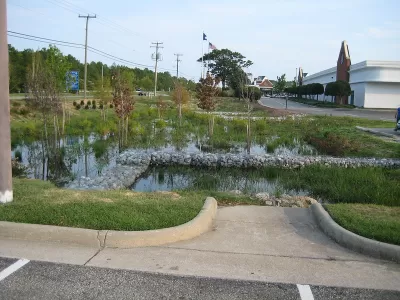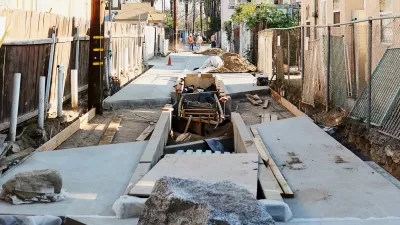How ‘sponge cities’ can protect residents and conserve water.

In an opinion piece in Next City, Franco Montalto touts the benefits of the ‘sponge city’ approach to flood mitigation that more and more cities are undertaking to protect their residents and infrastructure from catastrophic floods.
According to Montalto, “If this concept is to evolve into the new standard for urban design, city officials and developers will need to find ways to scale up and accelerate this work.”
Montalto explains that most U.S. stormwater management systems are not designed to handle all of the runoff created during a large storm. Now, cities are shifting to ‘green infrastructure’ to manage stormwater and direct it back into the ground rather than shuttling it out to rivers or oceans. This comes with its own challenges. “In the best cases, green infrastructure has been installed on publicly owned land and required on new or redesigned large-scale developments. It has proved much more challenging to incorporate green infrastructure on smaller, privately owned land parcels, which collectively make up a significant percentage of urban watershed areas.” In some areas, stormwater management is not even required as part of new development.
Montalto outlines some strategies cities can use to prevent flooding that include permeable asphalt, green roofs, rain gardens, and parks and green spaces designed to flood safely. Montalto also suggests ways to fund these efforts, pointing to collaborations between cities and nonprofit organizations as one option. “Cities could also offer incentives for retrofitting and scaling up existing stormwater management systems on private land. A trading system could be set up to sell the residual capacity to nearby property owners who lack onsite stormwater management opportunities.”
FULL STORY: Sponge Cities Are the Future of Urban Flood Mitigation

Planetizen Federal Action Tracker
A weekly monitor of how Trump’s orders and actions are impacting planners and planning in America.

Trump Administration Could Effectively End Housing Voucher Program
Federal officials are eyeing major cuts to the Section 8 program that helps millions of low-income households pay rent.

The 120 Year Old Tiny Home Villages That Sheltered San Francisco’s Earthquake Refugees
More than a century ago, San Francisco mobilized to house thousands of residents displaced by the 1906 earthquake. Could their strategy offer a model for the present?

Washington State Legislature Passes Parking Reform Bill
A bill that would limit parking requirements for new developments is headed to the governor’s desk.

Missouri Law Would Ban Protections for Housing Voucher Users
A state law seeks to overturn source-of-income discrimination bans passed by several Missouri cities.

Op-Ed: Looking for Efficiency? Fund Intercity Buses
Much less expensive than rail, intercity buses serve millions of Americans every year, but public subsidies are lacking.
Urban Design for Planners 1: Software Tools
This six-course series explores essential urban design concepts using open source software and equips planners with the tools they need to participate fully in the urban design process.
Planning for Universal Design
Learn the tools for implementing Universal Design in planning regulations.
Ada County Highway District
Clanton & Associates, Inc.
Jessamine County Fiscal Court
Institute for Housing and Urban Development Studies (IHS)
City of Grandview
Harvard GSD Executive Education
Toledo-Lucas County Plan Commissions
Salt Lake City
NYU Wagner Graduate School of Public Service




























